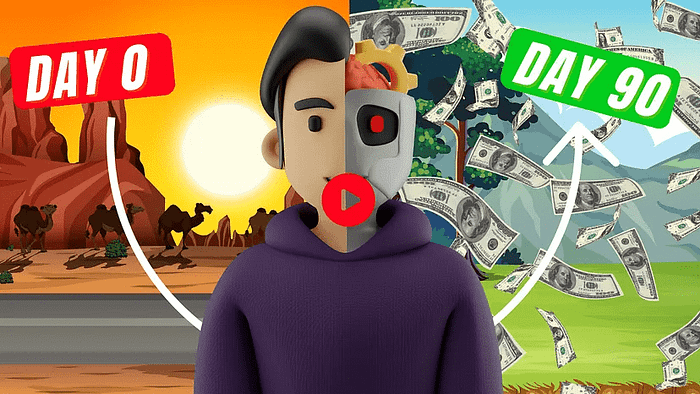ChatGPT-4 Forex Trading: A Beginner’s Experiment
Exploring the world of ChatGPT-4 Forex trading has been an eye-opening experience. As a newcomer to the foreign exchange market, I decided to embark on a fascinating journey to test the capabilities of artificial intelligence in generating profitable trades. With a $10,000 funded account at my disposal, I set out to discover whether ChatGPT-4 could guide me through the complex realm of currency trading and potentially yield positive results.
Throughout this experiment, I encountered various challenges and insights that shed light on the potential and limitations of AI-assisted trading. From selecting currency pairs to implementing risk management strategies, ChatGPT-4 provided valuable guidance that both intrigued and educated me along the way.
In this blog post, I’ll share my firsthand experience of using ChatGPT-4 for Forex trading, detailing the process, outcomes, and lessons learned. Whether you’re a curious beginner or an experienced trader interested in AI applications, this account offers a unique perspective on the intersection of artificial intelligence and financial markets.
We strongly recommend that you check out our guide on how to take advantage of AI in today’s passive income economy.
Table of Contents
Setting the Stage for ChatGPT-4 Forex Trading
The Premise of the Experiment
When I first conceived the idea of using ChatGPT-4 for Forex trading, I was both excited and apprehensive. The concept of leveraging artificial intelligence to navigate the complex world of currency exchange seemed almost too good to be true. I had heard stories of ChatGPT-4’s capabilities in various fields, from coding to creative writing, but could it really help a complete novice like me make profitable trades in the Forex market?
To test this hypothesis, I decided to set up a controlled experiment with clear parameters. I funded a trading account with $10,000, a substantial amount that would allow for meaningful trades while still being manageable for a beginner. The goal was simple: use ChatGPT-4’s guidance to make profitable trades and see if AI could indeed be a valuable tool for Forex trading.
Establishing the Rules of Engagement
Before diving into the actual trading, I needed to establish some ground rules for my interaction with ChatGPT-4. I decided on three simple principles that would govern our AI-assisted trading adventure:
- ChatGPT-4 would provide three random currency pairs for us to trade.
- It would suggest the percentage of risk we should take on each trade.
- The AI would advise on when to exit the market.
These rules were designed to give ChatGPT-4 a significant role in the decision-making process while still allowing for human oversight. After all, I wanted to test the AI’s capabilities, but I also needed to maintain control over my investment.
The Initial Conversation with ChatGPT-4
With my rules in place, I opened up the ChatGPT-4 interface and began our first conversation. The AI’s response was prompt and informative, immediately demonstrating its knowledge of Forex trading basics. It suggested focusing on major currency pairs due to their liquidity and lower volatility – a piece of advice that aligned with what I had read in my preliminary research.
ChatGPT-4 recommended three pairs for our experiment: EUR/USD, USD/JPY, and GBP/USD. These are indeed some of the most commonly traded pairs in the Forex market, known for their stability and frequent price movements. The AI also provided some quick tips about each pair, showcasing its understanding of their characteristics and the factors that influence their movements.
EUR/USD: The Classic Pair
As ChatGPT-4 explained, EUR/USD is known for its lower volatility and tight spreads, making it an excellent choice for beginners. This pairing, representing the Euro against the US Dollar, is the most traded currency pair in the world. Its popularity stems from the economic significance of both currencies and the relatively stable political environments of the Eurozone and the United States.
USD/JPY: The East-West Connection
The USD/JPY pair, linking the US Dollar and the Japanese Yen, was described by ChatGPT-4 as often moving predictably and being influenced by news from both the US and Japan. This pair is known for its sensitivity to interest rate differentials between the two countries and global risk sentiment.
GBP/USD: The Cable
Lastly, ChatGPT-4 suggested GBP/USD, often referred to as “The Cable” in trading circles. The AI warned that this pair can be more volatile, providing opportunities but also requiring careful risk management. The British Pound against the US Dollar is indeed known for its quick price movements, often reacting strongly to economic data from both countries.
Implementing ChatGPT-4’s Forex Trading Strategy
Decoding the AI’s Trading Recommendations
Armed with ChatGPT-4’s currency pair suggestions, I was eager to start trading. However, I needed more specific guidance on how to approach these trades. I asked the AI for a strategy to trade EUR/USD, including whether I should buy or sell, and what risk level to apply to my $10,000 account.
ChatGPT-4’s response was comprehensive and educational. It introduced me to the Simple Moving Average (SMA) strategy, a popular technical analysis tool used by many traders. The AI explained that this strategy involves using two SMAs – a 50-day and a 200-day – to identify trends and potential entry points.
The Simple Moving Average Strategy
The strategy ChatGPT-4 outlined was as follows:
- Identify the trend using 50-day and 200-day Simple Moving Averages (SMAs).
- If the 50-day SMA crosses above the 200-day SMA, it’s a buy signal (bullish crossover).
- If the 50-day SMA crosses below the 200-day SMA, it’s a sell signal (bearish crossover).
This approach, while simple, is grounded in solid technical analysis principles. Moving averages help smooth out price data to identify the overall trend direction, with crossovers potentially signaling changes in trend.
Risk Management Advice
I was impressed by ChatGPT-4’s emphasis on risk management, a crucial aspect of trading that many beginners overlook. The AI suggested risking no more than 1-2% of my account on a single trade, which translates to $100-$200 for my $10,000 account. This conservative approach aligns with best practices in trading, helping to preserve capital and weather potential losing streaks.
ChatGPT-4 also provided guidance on setting stop-loss and take-profit levels. For EUR/USD, it suggested a stop-loss of 50-100 pips away from the entry point and a take-profit target of 1.5 to 2 times the stop-loss distance. This risk-reward ratio of at least 1:1.5 is considered favorable by many traders, potentially allowing for overall profitability even with a win rate below 50%.
Preparing to Execute the Trade
With ChatGPT-4’s strategy in hand, I opened my trading platform and pulled up the EUR/USD chart. I added the 50-day and 200-day SMAs as suggested, color-coding them for easy identification. The blue line represented the 50-day SMA, while the red line showed the 200-day SMA.
As I observed the chart, I noticed that the 50-day SMA was below the 200-day SMA, suggesting a potential sell signal according to ChatGPT-4’s strategy. However, I was hesitant to enter a trade immediately without confirming the trend on multiple timeframes.
The Importance of Multiple Timeframe Analysis
While ChatGPT-4 had provided a solid foundation for analysis, I realized the importance of considering multiple timeframes before making a trading decision. I decided to look at the 4-hour chart in addition to the daily chart, seeking confirmation of the bearish trend.
This experience highlighted a key learning point in my ChatGPT-4 Forex trading journey: while AI can provide valuable insights, it’s crucial to combine these with comprehensive analysis and personal judgment.
Executing the First Trade
After careful consideration, I decided to follow ChatGPT-4’s guidance and enter a sell trade on EUR/USD. Using the position size calculator as suggested by the AI, I determined that a 0.4 lot size would keep my risk within the recommended 2% of my account.
With a mix of excitement and nervousness, I placed my first ChatGPT-4-inspired Forex trade:
- Pair: EUR/USD
- Direction: Sell
- Lot Size: 0.4
- Stop Loss: 50 pips from entry
- Take Profit: 100 pips from entry
As soon as I executed the trade, I felt a rush of adrenaline. The market immediately moved slightly in my favor, putting me in a small profit. However, I knew from my research that short-term movements don’t necessarily indicate the overall success of a trade.
Expanding the ChatGPT-4 Forex Trading Experiment
Exploring USD/JPY
With my EUR/USD trade in place, I turned my attention to the second pair ChatGPT-4 had suggested: USD/JPY. I was curious to see if the AI would recommend a different strategy for this pair or stick with the SMA approach.
I posed the question to ChatGPT-4, asking for specific buy or sell advice for USD/JPY on my $10,000 account. The AI’s response was thoughtful and nuanced, emphasizing the need to consider multiple factors before making a trading decision.
Market Analysis Considerations
ChatGPT-4 outlined several key considerations for trading USD/JPY:
- Market Sentiment: Assess the overall sentiment towards the US dollar and Japanese yen.
- Technical Analysis: Look at price action and key support and resistance levels on the USD/JPY chart.
- Fundamental Analysis: Consider recent economic news or events that may affect either currency.
This comprehensive approach impressed me, showing that ChatGPT-4 understood the complexity of Forex trading and the importance of considering multiple factors.
Simplifying the Approach
Recognizing that I had identified myself as a beginner, ChatGPT-4 then offered a simplified approach using the same SMA strategy it had suggested for EUR/USD. This consistency was helpful, allowing me to apply what I had learned from the previous trade.
Following the AI’s guidance, I set up my chart with the 50-period and 200-period SMAs on the 15-minute timeframe. The instructions were clear: if the 50-period SMA was above the 200-period SMA, consider buying; if below, consider selling.
The GBP/USD Trade
For the final currency pair, GBP/USD, I decided to challenge ChatGPT-4 to provide a different strategy. I was curious to see how versatile the AI could be in its trading recommendations.
To my surprise and appreciation, ChatGPT-4 smoothly transitioned to explaining a support and resistance strategy, demonstrating its broad knowledge of trading techniques. This strategy involved:
- Identifying support and resistance levels on the chart.
- Waiting for price action confirmation at these levels.
- Entering trades based on price bounces or rejections at support and resistance.
The AI also suggested using additional indicators like the Relative Strength Index (RSI) or Moving Average Convergence Divergence (MACD) to confirm trade signals. This layered approach to analysis showed ChatGPT-4’s understanding of the importance of confluence in trading decisions.
Executing the GBP/USD Trade
Armed with this new strategy, I analyzed the GBP/USD chart. I identified a clear resistance level where price had recently shown hesitation. Following ChatGPT-4’s advice, I waited for a rejection at this level before entering a sell trade.
My GBP/USD trade details were as follows:
- Pair: GBP/USD
- Direction: Sell
- Lot Size: 0.64 (based on the position size calculator)
- Stop Loss: 31 pips above the recent high
- Take Profit: 62 pips from entry (2x the stop loss)
As I executed this trade, I felt more confident than I had with the EUR/USD trade. The clear reasoning behind the entry, based on support and resistance levels, gave me a stronger sense of control over my trading decisions.
Reflecting on the ChatGPT-4 Forex Trading Experience
The Pros and Cons of AI-Assisted Trading
As I monitored my trades over the next couple of days, I had time to reflect on the pros and cons of using ChatGPT-4 for Forex trading.
Advantages of ChatGPT-4 in Forex Trading
- Educational Value: ChatGPT-4 provided clear, concise explanations of trading concepts and strategies. Its ability to break down complex ideas into digestible information was invaluable for a beginner like me.
- Strategy Diversity: The AI demonstrated knowledge of multiple trading strategies, from moving averages to support and resistance. This versatility allowed for a more comprehensive learning experience.
- Risk Management Focus: I appreciated ChatGPT-4’s consistent emphasis on proper risk management. This focus helped instill good habits from the start of my trading journey.
- Immediate Feedback: The ability to ask follow-up questions and receive instant clarification was incredibly helpful. It was like having a patient, knowledgeable mentor available 24/7.
Limitations of ChatGPT-4 in Forex Trading
- Lack of Real-Time Market Analysis: ChatGPT-4 couldn’t provide real-time market analysis or adapt to rapidly changing market conditions. Its advice was more general and strategic rather than tactical.
- Absence of Emotional Intelligence: The AI couldn’t account for the psychological aspects of trading, which are crucial in real-world scenarios. Managing emotions and maintaining discipline are essential skills that ChatGPT-4 couldn’t help with directly.
- Potential for Over-Reliance: There was a risk of becoming too dependent on the AI’s advice without developing independent analysis skills. It’s important for traders to learn to make their own decisions.
- Limited Contextual Understanding: While ChatGPT-4 could provide strategies, it couldn’t fully grasp the unique financial situation, risk tolerance, or trading goals of individual users.
The Outcome of the Trades
After two days, I closed out my positions to assess the results of my ChatGPT-4 Forex trading experiment. The outcomes were mixed:
- EUR/USD: This trade resulted in a profit of about $100. The market had moved in my favor, validating the SMA strategy suggested by ChatGPT-4.
- GBP/USD: Unfortunately, this trade hit my stop loss, resulting in a loss of $200. This outcome highlighted the inherent risks in Forex trading and the importance of proper risk management.
- USD/JPY: I hadn’t entered a trade on this pair due to lack of a clear signal during my trading window.
Overall, my account balance stood at $9,900, a net loss of $100 or 1% of my initial capital. While not the profitable outcome I had hoped for, this result provided valuable lessons about the realities of Forex trading.
Key Takeaways from the ChatGPT-4 Forex Trading Experiment
- AI as a Learning Tool: ChatGPT-4 proved to be an excellent educational resource, providing clear explanations of trading concepts and strategies. However, it should be used as a supplementary tool rather than a replacement for comprehensive trading education.
- The Importance of Practice: Paper trading or using a demo account before risking real money could have been beneficial. This would have allowed me to test ChatGPT-4’s strategies without financial risk.
- Emotional Control: Even with AI assistance, the emotional aspect of seeing real money at stake was challenging. Developing emotional discipline is crucial for successful trading.
- Continuous Learning: While ChatGPT-4 provided a solid starting point, I realized the need for ongoing education and practice to become a proficient trader.
- Risk Management is Key: The consistent emphasis on risk management by ChatGPT-4 was perhaps the most valuable aspect of this experiment. Limiting my risk per trade helped me avoid significant losses despite having losing trades.
Conclusion: The Future of AI in Forex Trading
My experiment with ChatGPT-4 Forex trading was an enlightening journey into the intersection of artificial intelligence and financial markets. While the AI demonstrated impressive knowledge and provided valuable guidance, it also highlighted the irreplaceable role of human judgment and emotional control in trading.
ChatGPT-4 proved to be an excellent educational tool, offering clear explanations of trading concepts and strategies. Its ability to provide diverse strategies and consistently emphasize risk management was particularly valuable. However, the lack of real-time market analysis and the potential for over-reliance on AI advice are important limitations to consider.
For beginners, ChatGPT-4 can serve as a helpful study guide, offering different perspectives on trading concepts. However, it should not be used as a sole decision-making tool for live trading. The complexity of the Forex market, with its myriad influencing factors and the crucial role of trader psychology, requires a more comprehensive approach than AI alone can provide.
As artificial intelligence continues to evolve, its role in Forex trading is likely to grow. Future iterations of AI may be able to provide more nuanced, real-time market analysis and even adapt to individual trader’s risk profiles and goals. However, the human element – the ability to integrate multiple sources of information, adapt to unexpected events, and manage emotions – will likely remain crucial in successful trading.
For those interested in exploring ChatGPT-4 Forex trading, I recommend using it as part of a broader learning strategy. Combine AI insights with traditional education resources, demo account practice, and gradual real-world experience. Remember that while AI can provide valuable information and strategies, the responsibility for trading decisions ultimately lies with the individual trader.
The Ethical Implications of AI in Forex Trading
As we consider the future of ChatGPT-4 Forex trading and AI in financial markets more broadly, it’s important to address the ethical implications of this technology.
Democratization of Information
On one hand, AI like ChatGPT-4 has the potential to democratize access to trading knowledge and strategies. It provides instant, 24/7 access to a vast amount of information that was previously only available to professional traders or through expensive courses. This democratization could level the playing field in the Forex market, allowing retail traders to compete more effectively with institutional players.
The Risk of Misinformation
However, the flip side of this accessibility is the risk of misinformation. While ChatGPT-4 is impressively knowledgeable, it’s not infallible. There’s a risk that inexperienced traders might take its advice as gospel, potentially leading to significant financial losses. It’s crucial for users to understand that AI should be a tool for learning and generating ideas, not a replacement for critical thinking and personal responsibility.
Market Impact
If AI-assisted trading becomes widespread, it could potentially impact market dynamics. For instance, if many traders are using similar AI-generated strategies, it could lead to more predictable market movements or, conversely, increased volatility as algorithms react to each other. The long-term effects of widespread AI use in trading are still uncertain and warrant careful study.
Integrating ChatGPT-4 into a Comprehensive Forex Trading Strategy
While my experiment with ChatGPT-4 Forex trading was relatively simple, I can envision more sophisticated ways to integrate AI into a comprehensive trading strategy.
AI for Market Research
One potential use of ChatGPT-4 in Forex trading is for efficient market research. The AI could quickly summarize recent economic events, central bank decisions, and geopolitical developments that might impact currency pairs. This could save traders significant time and provide a broad overview of market-moving factors.
Strategy Backtesting
Another interesting application could be using ChatGPT-4 to generate ideas for trading strategies, which traders could then backtest using historical data. This could potentially lead to the discovery of novel, effective trading approaches.
Risk Management Scenarios
ChatGPT-4 could also be valuable in running through various risk management scenarios. Traders could input different market conditions and ask the AI to calculate potential outcomes, helping to prepare for various market scenarios.
The Importance of Continuous Learning in Forex Trading
My experience with ChatGPT-4 Forex trading underscored the importance of continuous learning in the world of financial markets. The Forex market is dynamic, influenced by a complex interplay of economic, political, and social factors. No single source of information or analysis – whether human or AI – can provide a complete picture.
Combining AI Insights with Traditional Education
To become a proficient Forex trader, it’s crucial to combine insights from AI tools like ChatGPT-4 with traditional educational resources. This might include:
- Books and online courses on Forex trading
- Webinars and seminars by experienced traders
- Practice on demo accounts
- Gradual experience with real trading in small amounts
- Staying updated with financial news and economic indicators
Developing a Personal Trading Style
While ChatGPT-4 can provide valuable strategies and insights, every trader needs to develop their own style that fits their personality, risk tolerance, and financial goals. This personal style evolves through experience, learning from both successful and unsuccessful trades.
Final Thoughts on ChatGPT-4 Forex Trading
As I conclude this blog post on my ChatGPT-4 Forex trading experiment, I’m struck by both the potential and the limitations of AI in financial markets. ChatGPT-4 demonstrated an impressive breadth of knowledge about Forex trading strategies, risk management, and market analysis. Its ability to explain complex concepts in simple terms makes it an invaluable educational tool for beginners.
However, my experience also highlighted the irreplaceable value of human judgment, emotional control, and personalized strategy development in Forex trading. While AI can provide information and generate ideas, successful trading ultimately relies on the trader’s ability to integrate various sources of information, adapt to changing market conditions, and maintain discipline in the face of uncertainty.
For those intrigued by the potential of ChatGPT-4 Forex trading, I encourage you to explore this tool as part of a broader learning journey. Use it to generate ideas, clarify concepts, and gain new perspectives on trading strategies. But also invest time in traditional education, practice extensively on demo accounts, and start real trading with small amounts that you can afford to lose.
Remember, there’s no shortcut to becoming a successful Forex trader. It requires dedication, continuous learning, and the ability to learn from both successes and failures. While AI tools like ChatGPT-4 can be valuable allies in this journey, the ultimate responsibility – and the potential for success – lies with you, the trader.
As we look to the future, the integration of AI in Forex trading is likely to grow more sophisticated. We may see AI systems that can provide more personalized advice, real-time market analysis, and even automated trading based on complex algorithms. However, I believe the human element will remain crucial. The most successful traders will likely be those who can effectively combine AI insights with their own analysis, intuition, and emotional intelligence.
In conclusion, my experiment with ChatGPT-4 Forex trading has been an eye-opening journey into the potential of AI in financial markets. While it didn’t lead to immediate trading success, it provided valuable lessons and insights that will inform my future trading endeavors. As AI continues to evolve, it will undoubtedly play an increasingly important role in Forex trading. But for now, it remains a powerful tool in the trader’s arsenal – one that should be used wisely and in conjunction with comprehensive education and personal judgment.
FAQs:
Can ChatGPT-4 trade forex?
ChatGPT-4 itself is not designed to trade forex or make financial decisions. It’s a language model developed for generating text and providing information based on its training data. While it can assist with understanding forex trading concepts, analyzing market trends, or creating trading strategies, it does not execute trades or manage investments. For trading forex, specialized trading platforms and algorithms are required.
Can I use ChatGPT for trading?
While you cannot use ChatGPT to directly execute trades, it can be a valuable tool for learning and researching trading strategies. ChatGPT can help you understand trading concepts, provide insights on market analysis, and generate ideas for trading strategies. However, it’s important to pair this information with practical trading tools and professional advice for actual trading decisions.
Which AI is best for forex trading?
Several AI systems and platforms are specifically designed for forex trading. Some of the best options include:
- MetaTrader 4/5 with Expert Advisors (EAs): These platforms support automated trading strategies and algorithms.
- AlphaSense: Known for its advanced analytics and AI-driven insights.
- Kavout: Offers AI-driven trading signals and strategies.
- Trade Ideas: Provides AI-powered trade alerts and market analysis.
The best AI for forex trading depends on your specific needs, such as real-time analysis, strategy development, or automated trading.
Can AI predict forex?
AI can analyze vast amounts of historical and real-time data to identify patterns and make predictions about forex market trends. Machine learning algorithms can be trained to forecast price movements and generate trading signals. However, while AI can provide valuable insights and enhance trading strategies, it cannot guarantee accurate predictions due to the inherent volatility and unpredictability of financial markets.

We strongly recommend that you check out our guide on how to take advantage of AI in today’s passive income economy.




